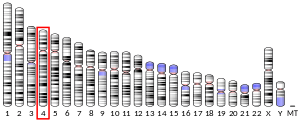DUX4
Double homeobox, 4 also known as DUX4 is a protein which in humans is encoded by the DUX4 gene.[3]
Gene
This gene is located within a D4Z4 repeat array in the subtelomeric region of chromosome 4q35. The D4Z4 repeat is polymorphic in length; a similar D4Z4 repeat array has been identified on chromosome 10. Each D4Z4 repeat unit has an open reading frame (named DUX4) that contains two homeoboxes; the repeat-array and ORF is conserved in other mammals. There was no evidence for transcription from standard cDNA libraries however RTPCR and in-vitro expression experiments indicate that the ORF is transcribed.[4]
Function
The encoded protein has been reported to function as a transcriptional activator of paired-like homeodomain transcription factor 1 (PITX1).[4]
Clinical significance
DUX is normally expressed in the testes and cleavage-stage embryos.[5]
Inappropriate expression of DUX4 in muscle cells is the cause of facioscapulohumeral muscular dystrophy.[6][7]
Overexpression of DUX4 due to translocations can cause B cell leukemia.[5]
References
- ENSG00000283949 GRCh38: Ensembl release 89: ENSG00000260596, ENSG00000283949 - Ensembl, May 2017
- "Human PubMed Reference:". National Center for Biotechnology Information, U.S. National Library of Medicine.
- Gabriëls J, Beckers MC, Ding H, De Vriese A, Plaisance S, van der Maarel SM, et al. (August 1999). "Nucleotide sequence of the partially deleted D4Z4 locus in a patient with FSHD identifies a putative gene within each 3.3 kb element". Gene. 236 (1): 25–32. doi:10.1016/S0378-1119(99)00267-X. PMID 10433963.
- "Entrez Gene: DUX4 Double homeobox, 4".
- Lee JK, Bosnakovski D, Toso EA, Dinh T, Banerjee S, Bohl TE, et al. (December 2018). "Crystal Structure of the Double Homeodomain of DUX4 in Complex with DNA". Cell Reports. 25 (11): 2955–2962.e3. doi:10.1016/j.celrep.2018.11.060. PMC 6463520. PMID 30540931.
- Lemmers RJ, van der Vliet PJ, Klooster R, Sacconi S, Camaño P, Dauwerse JG, et al. (September 2010). "A unifying genetic model for facioscapulohumeral muscular dystrophy". Science. 329 (5999): 1650–3. Bibcode:2010Sci...329.1650L. doi:10.1126/science.1189044. PMC 4677822. PMID 20724583.
- Jones TI, Chen JC, Rahimov F, Homma S, Arashiro P, Beermann ML, et al. (October 2012). "Facioscapulohumeral muscular dystrophy family studies of DUX4 expression: evidence for disease modifiers and a quantitative model of pathogenesis". Human Molecular Genetics. 21 (20): 4419–30. doi:10.1093/hmg/dds284. PMC 3459465. PMID 22798623.
This article incorporates text from the United States National Library of Medicine, which is in the public domain.

